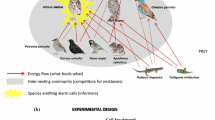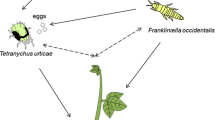Abstract
We describe a field experiment designed to evaluate indirect effects in a prey community sharing common predators. A simple prey community was mimicked with two types of artificial nests. Firstly, it was shown that predation rate increased with nest density when only a single prey was present. Secondly, it was shown that an increase in the density of one nest type increased the predation rate on another type. This is the first experimental evidence for indirect effects in vertebrate communities, which also may help to explain the strong interspecific aggression observed in some communities. In a previous treatment we had shown that there is no observer effect on nest predation in the form of density-dependent scent marking while laying out the artificial nests.
Similar content being viewed by others
References
Andren H (1991) Predation: an overrated factor for over-dispersion of birds nests? Anim Behav 41:1063–1070.
Begon M, Harper JL, Townsend CR (1988) Ecology. Individuals, populations and communities. Blackwell, Oxford
Bergelson J (1985) A mechanistic interpretation of prey selection by Anax junius larvae (Odonata: Aeschnidae). Ecology 66:1699–1705
Brikhead TR, Greene E, Biggins JD, Nettleship DN (1985) Breeding site characteristics and breeding success in thick-billed murres Can J Zool 63:1880–1884
Bond AB (1983) Visual search and selection of natural stimuli in the pigeon: the attention threshold hypothesis. J Exp Psychol anim Behav Proc 9:292–306
Buitron D, Nuechterlein GL (1985) Experiments on olfactory detection of food chaches by black-billed magpies. Condor 87: 92–95
Catchpole C, Leisler B (1986) Interspecific territorialism in reed warblers: a local effect revealed by playback experiments. Anim Behav 34:299–300
Cooper SD (1984) The effect of trout on water striders in stream pools. Oecologia 63:376–379
Cornell H, Pimentel D (1978) Switching in the parasitoid Nasonia vitripennis and its effects on host competition. Ecology 59:297–308
Curio E (1976) The ethology of predation. Springer, Berlin Heidelberg New York
Esler D, Grand JB (1993) Factors influencing depredation on duck nests. J Wildl Manage 57:244–248
Faivre B, Auger PM (1993) competition and predation models applied to the case of the sibling bird species of Hippolais in Burgundy. Acta Biotheor 41:23–33
Gendron RP (1986) Searching for cryptic prey: evidence for optimal search rates and the formation of search images in quail. Anim Behav 34:898–912
Glutz von Blotzheim UN, Bauer K (1991) Handbuch der Vögel Mitteleuropas, vol 12. Aula, Wiesbaden
Guilford T, Dawkins MS (1987) Search images not proven: a reappraisal of recent evidence. Anim Behav 35:1838–1845
Hoi H (1989) Ökologie und Paarungssystem der Bartmeise Panurus biarmicus. D Phil Thesis, University of Vienna
Hoi H, Winkler H (1988) Feinddruck auf Schilfbrüter: eine experimentelle Untersuchung. J Ornithol 129:439–447
Hoi H, winkler H (1991) Feinddruck auf Vogelnester: Effekte der Habitatkomplexität. J Ornithol 132:215–217
Hoi H, Eichler T, Dittami JP (1991) Territorial spacing and interspecific competition in three species of reed warblers. Oecologia 87:443–448
Holt RD (1977) Predation, apparent competition, and the structure of prey communities. Theor Popul Biol 12:197–229
Holt RD (1993) Apparent competition and enemy-free space in insect host-parasitoid communities. Am Nat 142:623–645
Jeffries MJ, Lawton JH (1984) Enemy-free space and the structure of ecological communities. Biol J Linn Soc 23:269–286
Krebs J (1971) Territory and breeding density in the great tit (Parus major L). Ecology 52:2–22
Lawrence ES (1989) Why blackbirds overlook cryptic prey: search rate or search image? Anim Behav 37:157–160
Lawton JH, Beddington JR, Bonser R (1974) Switching in invertebrate predators. In: Usher MB, Williamson MH (eds) Ecological stability. Chapman and Hall, London, pp 141–158
Leisler B (1988) Interspecific interactions among European march-nesting passerines. Acta Congr Int Ornithol XIX: 2635–2644
Lienert GA (1986) Verteilungsfreie Methoden in der Biostatistik, vol 1. Anton Hain, Meisenheim
Mankin PC, Warner RE (1992) Vulnerability of ground nests to predation on an agricultural habitat island in East-Central Illinois. Am Midl Nat 128:281–291
Martin TE (1988a) Habitat and area effects on forest bird assemblages: is nest predation an influence? Ecology 69: 74–84
Martin TE (1988b) On the advantage of being different: nest predation and the coexistence of bird species. Proc Natl Acad Sci USA 85:2196–2199
Murdoch WW, Avery S, Smith MGB (1975) Switching in predatory fish. Ecology 56:1094–1105
O'Reilly P, Hannon SJ (1989) Predation of simulated willow ptarmigan nests: the influence of density and cover on spatial and temporal patterns of predation. Can J zool 67:1263–1267
Page GW, Tenzel LE, Winkler DW, Swarth CW (1983) Spacing out at Mono lake: breeding success, nest density and predation in the snowy plover. Auk 100:13–24
Picman J (1984) Experimental study on the role of intra- and interspecific competition in the evolution of nest-destroying behavior in marsh wrens. Can J Zool 62:2352–2356
Picman J (1988) Experimental study of predation on eggs of ground-nesting birds: effects of habitat and nest distribution. Condor 90:124–131
Reitsma L (1992) Is nest predation density-dependent? — A test using artificial nests. Can J Zool 70:2498–2500
Ricklefs RE (1989) Nest predation and the species diversity of birds. Trends Ecol Evol 4:184–186
Royama T (1970) Factors governing the hunting behaviour and selection of food by the great tit (Parus major L.). J Anim Ecol 39:619–668
Staddon JER, Gendron RP (1983) Optimal detection of cryptic prey may lead to predator switching. Am Nat 122:843–848
Strauss SY (1991) Indirect effects in community ecology: their definition, study and importance. Trends Ecol Evol 6:206–210
Sugden LG, Beyersbergen GW (1986) Effects of density and concealment of american crow predation of simulated duck nests. J Wildl Manage 50:9–14
tinbergen L (1960) The dynamics of insect and bird populations in a pine wood. Arch Neerl Zool 13:259–473
Velarde E (1992) Predation of Heermanns gull (Larus heermanni) chicks by yellow-footed gulls (Larus livens) in dense and scattered nesting sites. Colon Waterbirds 15:8–13
Vickery PD, Hunter ML, Wells J, Wells JV (1992) Evidence of incidental nest predation and its effects on nests of threatened grassland birds. Oikos 63:281–288
Wesneat DF (1992) Nesting synchrony by female red-winged blackbirds — effects on predation and breeding success. Ecology 73:2284–2294
Author information
Authors and Affiliations
Rights and permissions
About this article
Cite this article
Hoi, H., Winkler, H. Predation on nests: a case of apparent competition. Oecologia 98, 436–440 (1994). https://doi.org/10.1007/BF00324234
Received:
Accepted:
Issue Date:
DOI: https://doi.org/10.1007/BF00324234




